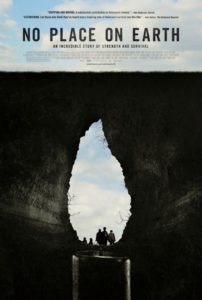 This is a guest post by Laura French.
This is a guest post by Laura French.
Most of the time, “going underground” is a metaphor. For an extended family of Ukrainian Jews, going underground was literally the key to surviving the Holocaust. Their story—and that of the American caver who spent 10 years unearthing their harrowing and inspiring story—is told in the documentary No Place on Earth, coming to the Edina Cinema on April 26.
For more than 600 days, 38 members of the Wexler/Stermer clan, ranging in age from 2 years to 70, lived deep underground in two different limestone caves. The year-round temperature was 52 degrees, humidity was 100 percent and the darkness was absolute except for a couple of 10-minute periods of candlelight each day.
To put that in perspective: The “official” record for underground survival is held by Michael Siffre, who lasted 205 days supported by sophisticated equipment and a team of scientists aboveground monitoring his well being. Even so, Siffre called the experience “the nadir of my life.”
The Wexler/Stermer family survived three times longer, in constant danger, yet their return to the cave, 60 years after the end of the war, has elements of sentimental journey and family reunion. What the survivors remember all of these years later, is their mother’s courage, their oldest brother’s ingenuity and the gratitude and amazement they felt when they finally emerged into sunlight.
Their 2003 visit to the cave was made possible by a New York detective and amateur caver named Chris Nicola, who began exploring in Ukraine’s limestone caves in 1993. In one of the caves, he found artifacts that hinted at human habitation: buttons, shoes and a rusted key. The Ukrainian villagers mostly professed ignorance, but eventually someone told Nicola that the cave was “where the Jews hid.”
For 10 years, Nicola continued to explore the cave and send out inquiries about the cave dwellers. Eventually, he received an email from the son-in-law of one of the survivors, who lived just 30 minutes from Nicola in Brighton Beach. Finding and interviewing the survivors in New York, Florida and Montreal only intensified Nicola’s interest. In 2007, he and co-writer Peter Lane Taylor wrote a book, The Secret of Priest’s Grotto, published by Kar-Ben Publishing in Minneapolis. The documentary followed in 2012.
The title of the movie comes from a line in a self-published memoir by Edith Stermer, matriarch of the clan. Recalling the time when it became necessary to flee from the Nazis, she wrote, “We had vigor, ingenuity and determination to survive. Above all our family would stand together…But where could we go? Clearly, there was no place for us on earth.”
Edith Stermer’s determination was integral to her family’s survival. In one of the film’s most chilling scenes, she faces down a group of Nazi’s who invade their first hiding place. Her quick thinking saves several of her children from being taken away to the death camps.
“We were masters of our own fate in the cave,” she wrote.
The historical portions of the film are agonizing; the dedication of Chris Nicola is inspiring. The story is filled with the strange and wonderful coincidences that prove truth is indeed stranger than fiction.
No Place on Earth played to a packed house at the Twin Cities Jewish Film Festival. Word of mouth will undoubtedly draw a crowd for the commercial run. It’s a story that sheds new light on the strength and resilience of the human spirit.
Laura French is a freelance writer who lives in north Minneapolis, two blocks from the Victory Memorial bike trail. She is a member of Temple Israel. One of the stated goals in her conversion statement was to become a Jewish writer, and she is grateful to TC Jewfolk for advancing her in that goal.

